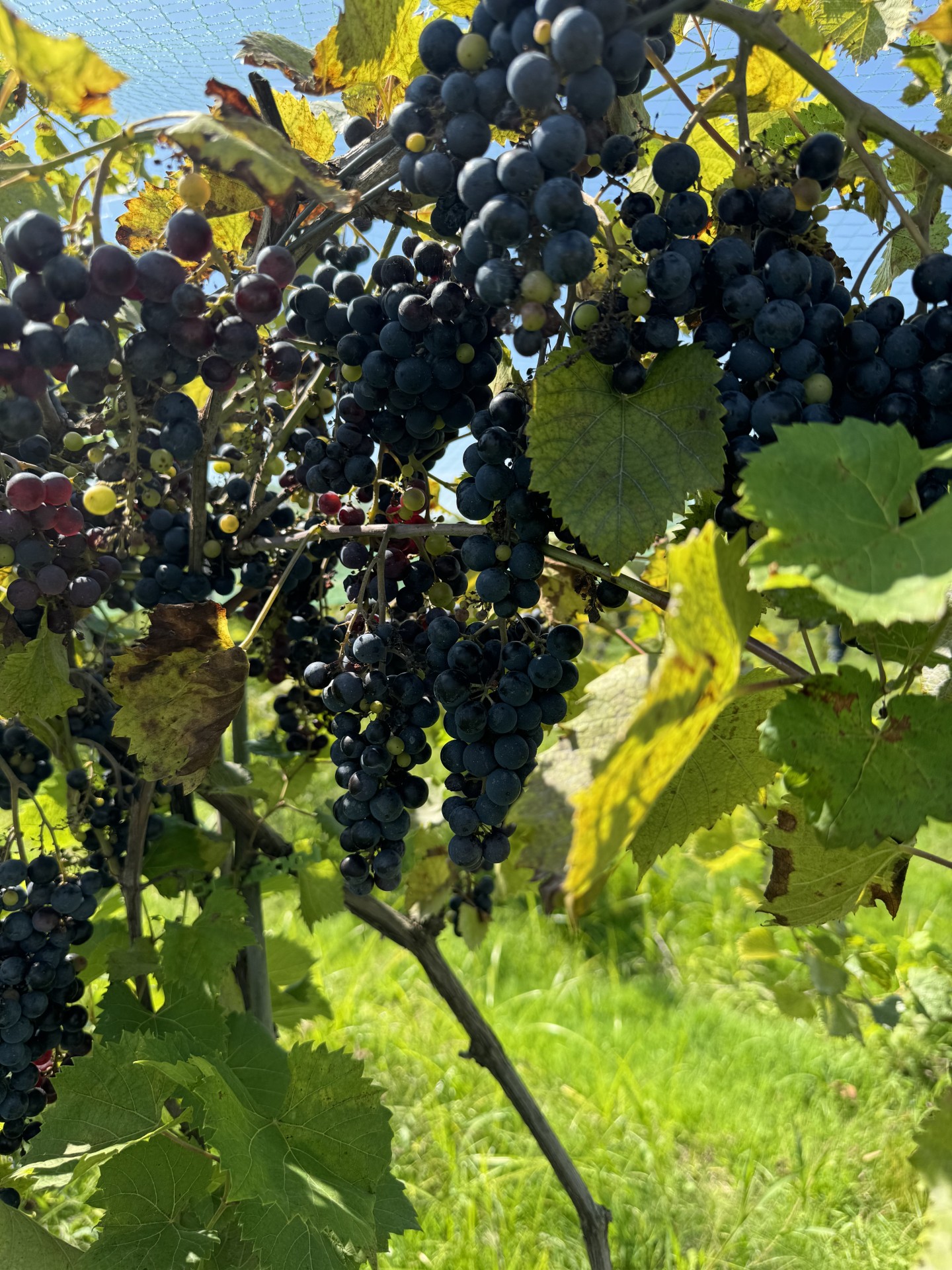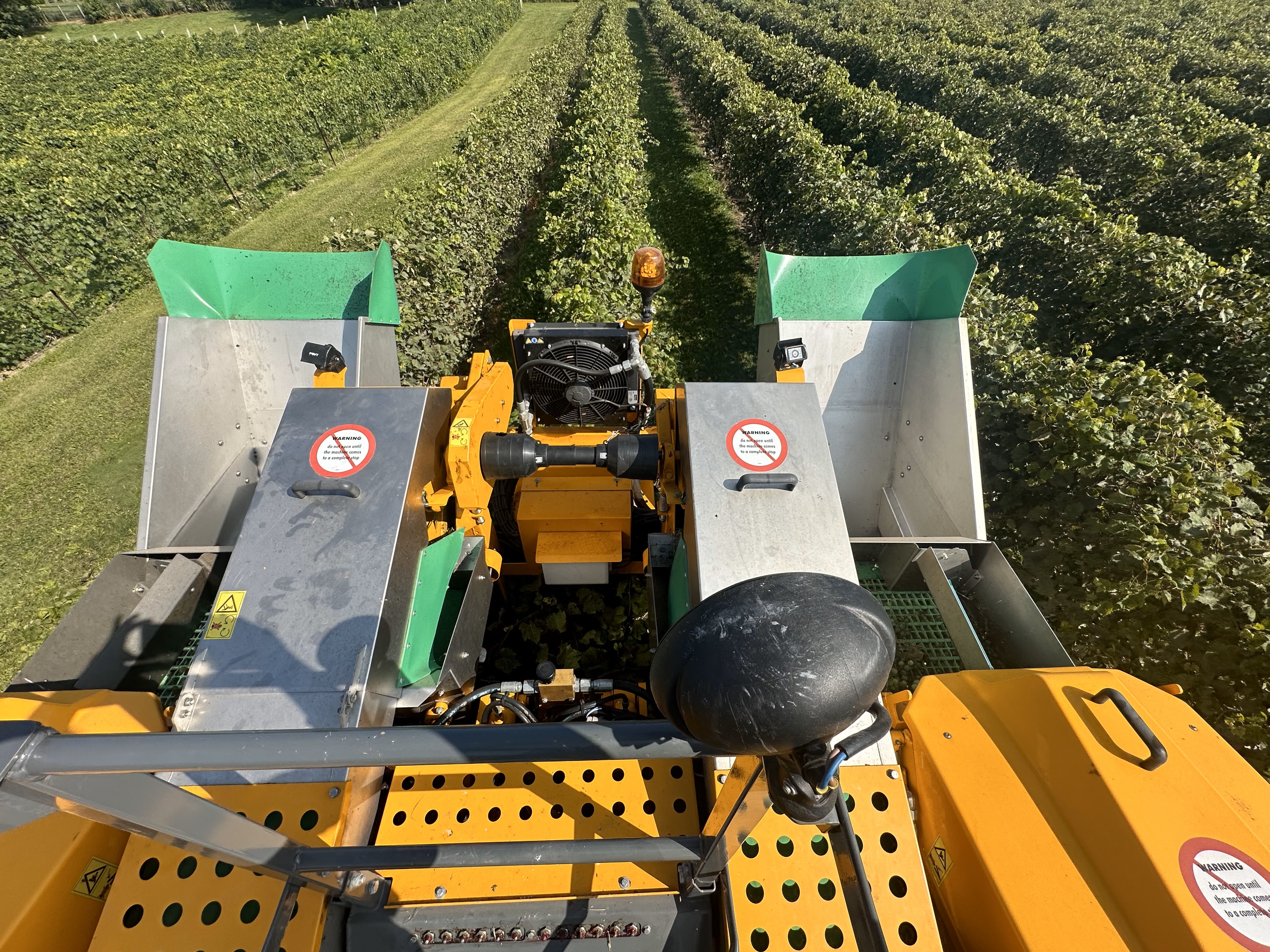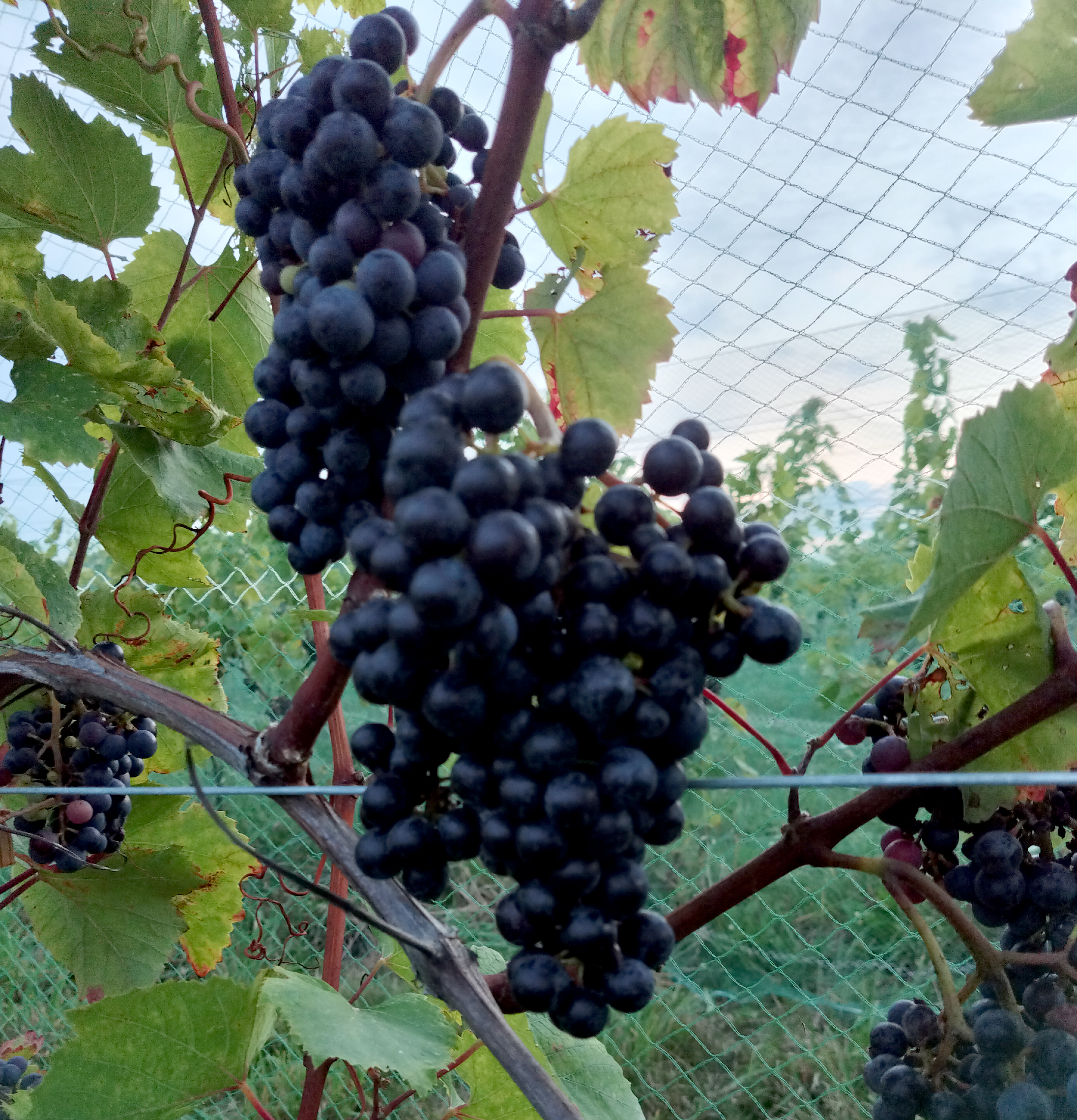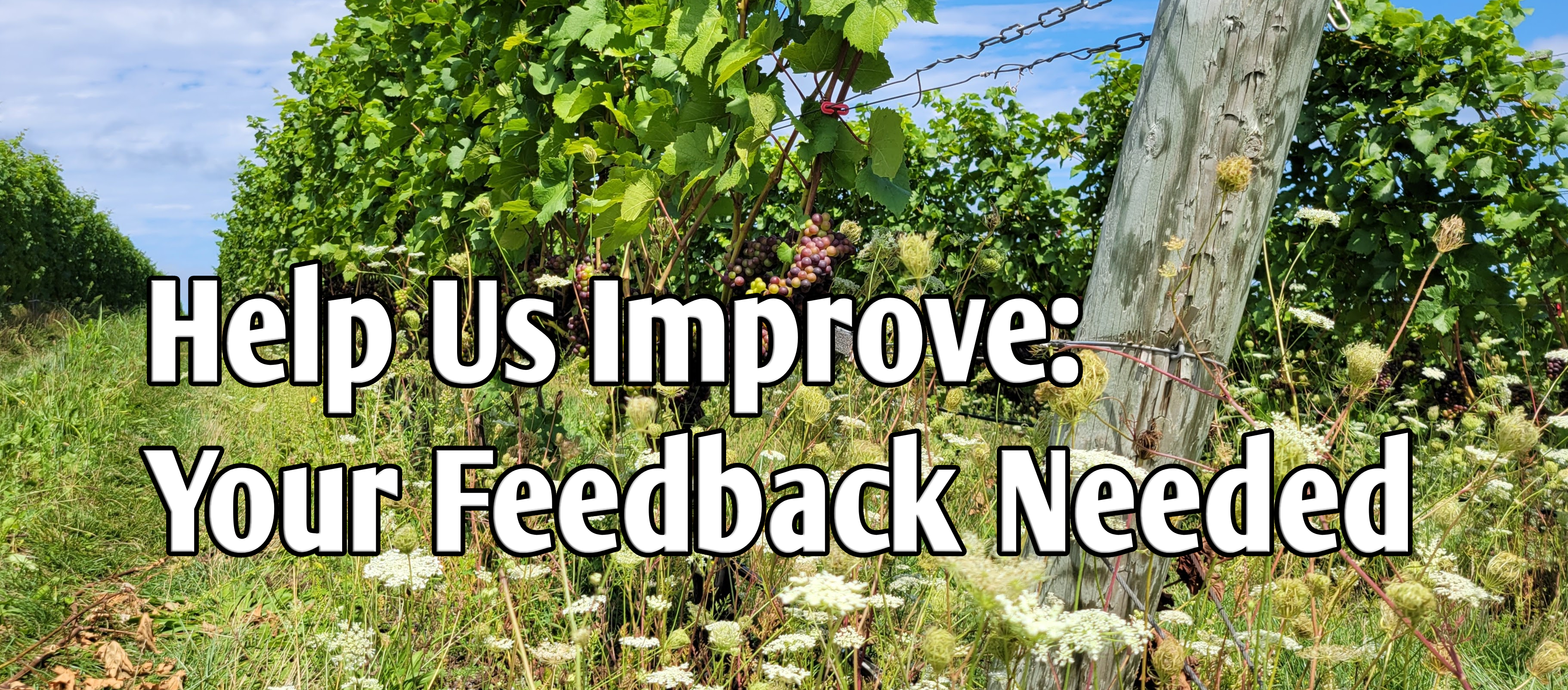Michigan grape scouting report – September 11, 2024
Stay informed and ahead of the curve with the latest vineyard updates and best practices in our comprehensive report. Enhance your grape growing success by leveraging expert insights on vine growth, disease management and innovative tools.

Weather
Click the following links for detailed seven-day forecasts for various grape production regions.
Southwest
Southeast
Northwest
See the latest agricultural weather outlook from Jeff Andresen, Michigan State University (MSU) state climatologist.
Check out the MSU Enviroweather Growing Degree Days (GDD) Michigan map. Find your closest weather station, create an account on the website, and track GDDs daily.
Report on growing degree days (GDD)
The following table summarizes the GDD base 50 degrees Fahrenheit for the current week and the previous week, as well as the accumulated GDD for each location.
|
Michigan grape growing region |
Current GDD 50 F Update 9/11/24 |
GDD 50 F last week 9/4/24 |
Collected the past week |
|---|---|---|---|
|
Benton Harbor (SWMREC) |
2733.9 |
2657.2 |
77 |
|
Fennville |
2481.1 |
2418.9 |
62 |
|
Lawton |
2687.9 |
2612 |
76 |
|
Average for southwest Michigan |
2634.3 |
2562.7 |
72 |
|
Romeo |
2540.2 |
2467.5 |
73 |
|
Average for southeast Michigan |
2540.2 |
2467.5 |
73 |
|
Old Mission |
2017.8 |
1960.4 |
57 |
|
Petoskey |
1990.6 |
1932.2 |
58 |
|
Traverse City (NWMHRS) |
2187.6 |
2121.2 |
66 |
|
Average for northwest Michigan |
2065.3 |
2004.6 |
61 |
Vine growth
Southwest Michigan
Harvest is expanding. With the light crop and the warm season, many varieties are ahead of schedule. That said, several growers are taking advantage of the dry weather and delaying harvest to improve ripeness. Vinifera harvest is starting with Pinot Gris and other early varieties being harvested this week. Juice grape vineyards smell great right now. Concord sugar levels are around 14 Brix, Niagara measuring near 16 Brix. The National Grape Cooperative has scheduled the start of Niagara harvest for Sept. 23 with Concords starting five days later on Sept. 28.
Southeast Michigan
Seedless table grape varieties are slowing down in Britton, with ‘Mars’ harvest coming soon. Spot picking of ‘Concord’ has started in Britton, while it is expected in Romeo in the next week. ‘Fredonia’ harvest in Romeo is finished and ‘Niagara’ is expected soon. Harvest continues in cold-hardy wine grapes, with ‘Marquette’ spot harvest starting. Harvest at Youngblood has concluded in ‘Petite Pearl,’ ‘Prairie Star,’ and ’Itasca.’ ‘Frontenac’ and ‘Frontenac Blanc’ are next on deck for harvest. In the Flint area growers have reported the harvest of ‘Itasca’ and ‘Marquette’ with ‘Vignoles’ ready soon.
The next week will be fair and dry with some cloud cover over the weekend. We expect warmer and drier conditions later in the month. RimPro models for Romeo through Sept. 20 indicate a high risk of black rot conidia infection from Sept. 17-19. Downy mildew risk will be high on Sept. 18-20. Powdery mildew will be in severe infection risk for the entire week through Sept. 18.


Northern Michigan
In most vineyards in northern Michigan, the majority of grape varieties have passed veraison. Some vineyards are now harvesting for sparkling wine production. While sugar levels continue to rise, the grapes have nearly reached their full size. (E-L numbers 36-37).
Tip of the Mitt region
Early hybrid cultivars have completed veraison with later ripening cultivars still in the process. Harvest on some early hybrids will likely begin this week. Vinifera cultivars are proceeding through veraison. Powdery mildew pressure seems persistent in susceptible cultivars. Growers have begun preventative measures to protect grapes from bird predation.

|
Variety |
Northwest region (Brix) |
Tip of the Mitt region (Brix) |
Southwest region (Brix) |
Southeast region (Brix) |
|---|---|---|---|---|
|
Riesling |
15.8 |
- |
18.6 |
- |
|
Chardonnay |
18.1 |
- |
- |
- |
|
Pinot noir |
18.8 |
- |
22.5 |
- |
|
Pinot Blanc |
17.6 |
- |
- |
- |
|
Pinot Gris |
19.1 |
- |
- |
- |
|
Cabernet Franc |
15.2 |
- |
20.3 |
- |
|
Marquette |
- |
20.3 |
|
22 |
|
Itasca |
- |
21.1 |
|
24.0* |
|
Seyval |
- |
- |
22.7 |
- |
|
Prairie Star |
- |
- |
- |
|
|
Aromella |
- |
- |
- |
- |
|
Concord |
- |
- |
14 |
|
|
Niagara |
- |
- |
16 |
- |
|
Chancellor |
- |
- |
- |
- |
*Harvested
Horticulture
Vineyard hedging has been going on in Michigan for several weeks. The primary focus for hedging is on curtailing excessive primary and lateral shoot growth on the canopy's top and sides to prevent cluster zoneshading. By doing so, the vineyard becomes more accessible for workers and tractors. Interestingly, hedging also stimulates growth by promoting lateral shoot development in vigorous vines, despite the reduction of the canopy due to the removal of primary and lateral shoots. It is recommended to perform hedging during the early to mid-summer period. Ideally, hedging is carried out between fruit set and veraison. This timing is crucial as it ensures adequate exposure of leaves, fruit, and developing buds to sufficient light, especially in dense canopies of hybrid cultivars with excessive vegetative growth. To avoid potential issues, it is essential to refrain from hedging too early in the growing season, as it may lead to increased lateral growth and canopy density.
Cluster zone leaf removal at the pre-veraison stage (mechanical or manual) is a critical viticultural practice with significant benefits for grape quality. By removing leaves around the grape clusters before veraison (the onset of ripening), growers can improve sunlight exposure and air circulation within the canopy. This increased exposure to sunlight enhances the development of desirable phenolic compounds and promotes even ripening, leading to better color, flavor, and aromatic profiles in the grapes. Improved air circulation reduces humidity around the clusters, which lowers the risk of fungal diseases such as powdery mildew and botrytis bunch rot, contributing to healthier fruit and reduced need for chemical treatments.
In Michigan viticulture, particularly with hybrid grape varieties, late-season crop reduction does not yield the same improvements in fruit quality as early-season crop load adjustments. While early thinning effectively enhances the quality of the remaining fruit by improving parameters such as sugar content, flavor concentration, and acidity balance, reductions made after veraison, when the grapes begin to ripen, fail to significantly impact these characteristics. This is especially critical for hybrids, which are often pruned with an excessive number of buds to safeguard against potential spring frost damage. Without timely crop control, these vines can produce an overly large crop, leading to poor fruit quality marked by retained rustic flavors and elevated acidity, which negatively affects the wine produced from these grapes.
The science of winemaking is both intricate and precise yet determining the optimal time for grape harvest lacks a universal formula due to the multitude of variables that must be considered. Historically, winemakers adhered to the "100-day rule," harvesting grapes approximately 100 days after flowering. However, modern winemaking has evolved, with technological advancements, shifting consumer preferences, and climate change making the timing of harvest more flexible, often falling within a broader harvest window. Flavor is paramount in determining the optimal ripeness and harvest timing, although it requires significant expertise to accurately assess. Winemakers aim to balance sugar ripeness and phenolic ripeness. Phenolic compounds, including tannins, flavonoids and anthocyanins, play key roles in the color, bitterness, and astringency of wine, all of which are critical for developing the desired flavor profile. Ideally, ripeness is achieved when there is sweetness without bitterness, accompanied by a harmonious balance between sugar and acidity.
Acidity levels significantly impact the final wine's profile; excessive acidity (low pH) can produce overly tart or astringent wine, while insufficient acidity (high pH) can result in a wine that is perceived as "flabby" and lacking in structure. For red wines, the optimal pH at harvest generally falls between 3.3 and 3.5, while white and rosé wines are best harvested when pH is between 2.9 and 3.3. While experience remains critical, technology increasingly aids modern winemakers in determining harvest readiness. Refractometers, commonly used to measure grape sugar content (Brix), provide a clear indication of the potential alcohol content in wine. Sparkling wine grapes are typically harvested when Brix levels range from 18 to 20, while still wine grapes are harvested at Brix levels between 19 and 25. Brix values provide insight into the amount of fermentable sugars in the grapes, helping predict the wine’s alcohol content.
In addition to measuring sugar, winemakers frequently analyze titratable acidity (TA) and pH to evaluate the grapes' overall acidity. These measures are essential for achieving the wine's flavor balance. Red wines typically aim for TA values of 6.5 to 7.5 g/L, while white and rosé wines target slightly higher TA values between 6.5 and 9 g/L. Several wineries in Michigan before harvest also performs analysis on phenolic compounds, including tannins, flavonoids, and anthocyanins couple with berry sensory analysis to decide the time of harvest. Weather patterns can heavily influence the timing of the harvest. Prolonged rainfall or extreme heat can damage grape quality, leading winemakers to pick grapes earlier than planned to avoid crop loss. This is especially common in regions like Michigan, where heavy rain during the ripening period can cause grapes, such as Pinot Noir, to swell, increasing the risk of cluster rot and resulting in undesirable reduction flavors in the wine.
Additionally, ripening does not occur uniformly across the vineyard. Factors such as wind, sunlight exposure and soil variation cause some rows of vines to ripen at different rates, further complicating harvest timing. The type of grape and intended wine style also influence the optimal ripeness level for harvest. Sparkling wine producers often seek slightly under-ripe grapes to retain higher acidity, which is crucial for the style’s structure and freshness. In contrast, varieties such as Merlot and Cabernet Franc may benefit from slight overripeness, which enhances the richness of the wine and reduces methoxypyrazines, compounds that contribute to "green" or vegetal flavors, especially in Bordeaux varieties grown in Michigan. Harvesting grapes is a multifaceted process that relies on a careful blend of visual, chemical, and environmental cues, supported by both experience and technology. Winemakers must judiciously balance sugar levels, acidity, and phenolic ripeness to craft a wine that meets their stylistic and quality goals.
Diseases
During this time of the year, the primary diseases of concern for grape growers are phomopsis, black rot, anthracnose and powdery mildew. If you're seeking detailed insights into pre-bloom fungicide options and the effects of rain on disease spread, we recommend referring to a grape scouting report from earlier or exploring an article on early-season disease management. It's worth noting that some growers have recently observed isolated cases of downy mildew infections in northern vineyards. Southern vineyards have been seeing early infections of Phomopsis and are beginning to see black rot lesions on fruit and leaves. Powdery mildew symptoms are becoming more apparent, so vineyards should be scouted to check on the status of diseases.
With the exception of powdery mildew, these spring disease infections typically require rain events. It only takes 0.1 inches of rain above 50 degrees Fahrenheit to trigger a possible infection. Viticultural practices that reduce canopy wetness such as good irrigation timing, leaf removal and good weed management can reduce many of these diseases in a vineyard. Typically, DMIs (FRAC 3), captan and EBDCs (FRAC M3) are effective for Phomopsis, black rot and anthracnose.
Remember, as you choose a fungicide, check the Michigan Fruit Management Guide for potential phytotoxicity of certain sprays on Concord grapes especially (this has been particularly noted for fungicides like Revus Top). Phytotoxicity risk is higher with high temperatures and quickly growing vines. Also, there is a significant phytotoxicity risk with specific contact products such as copper and sulfur for Labrusca type grapes (Concord and Niagara).
It is important to remember to manage fungicide resistance and avoid applying similar products back-to-back. This is particularly important with site-specific systemic fungicides. To reduce the development of resistance with systemic fungicides:
- Do not make more than two applications per season of the same FRAC code.
- Do not make two consecutive applications of the same FRAC code.
- Rotate with unrelated fungicides in a different FRAC code that have efficacy on the target pathogen.
- Include a contact multisite fungicide into a program (e.g., sulfur, captan, oils or biological fungicides).
Since some parts of the state are near veraison, this is also an important time to consider botrytis management. Botrytis has been spotted in many early ripening varieties like Marquette, and sporulation can be seen on infected berries that were likely started by berry moth infestations. Several strategies contribute to good botrytis bunch rot management including opening up the canopy, effective insect control, properly applying fungicides and using resistant cultivars when possible.
Good botrytis control depends on getting good coverage. Just before bunch closure is the last chance to apply a fungicide to the inner part of the developing cluster. The most effective products for botrytis are site specific and prone to resistance development. A Michigan Grape Fact Sheet is available for managing botrytis bunch rot.
In the Tip of the Mitt region, many vineyards have reported a high pressure of downy mildew this year. Hybrid cultivars have needed spraying for downy mildew, with entire hybrid vineyards showing outbreaks.
Insects
Control of insect pests has generally been good this season, except for a few hot spot locations where berry moth infestation is high. Even then the damage is mostly at vineyard borders, so treating at the border might be possible if your rows run the right way. With harvest starting in southwest Michigan table grapes, we are into the period where any spray decisions need to consider restricted entry intervals and preharvest intervals for timing harvest activity.
This time of year we also consider whether there will be a significant fourth generation of grape berry moth. This is expected to be moderate in 2024 because although the early timing of the third generation has “primed the pump” for a fourth generation, there are many factors also pushing back against it. Current populations of berry moth aren't very high, the weather this week has been extremely hot, and many vineyards will be harvested early. Scouting clusters this week in the Lawton, Michigan, area, we found many berries with damage but no larvae or with larvae that weren’t moving. At sites in southern Michigan with low grape berry moth pressure so far, additional treatment is unnecessary and won’t provide an economic return. At vineyards with significant infestation from the third generation, where harvest is still three or more weeks away, protection from grape berry moth is warranted to minimize a late-season surge from berry moth. Look for options with low enough preharvest intervals to avoid any problems with harvest timing.
Examination of our degree-day model for berry moth currently indicates that the southern Berrien County station at the Southwest Michigan Research and Extension Center with a May 16 biofix predicts an Aug. 31 start date for generation four egglaying. For Lawton with a May 20 biofix, the model predicts Sept. 3 or 4. For Fennville with a May 22 biofix, the model currently predicts well beyond the forecastable weather, so that timing would be further into September.
MSU is working with state and federal agencies monitoring sites across the state for spotted lanternfly, including multiple vineyard locations. Growers can help out by reporting any suspect detections to the Department of Natural Resource’s Eyes In The Field.
Your feedback is needed!

As the harvest season gets underway, we wish you a successful and fruitful time in your vineyards and wineries. Your experiences and insights are vital to the success of Michigan's grape and wine industry, and we’re eager to hear from you.
We’re conducting a brief survey to evaluate the effectiveness of our educational and outreach programs over the past four years. Your feedback will help us understand how our efforts have supported your vineyard or winery and identify areas where we can improve.
The survey consists of just four straightforward questions and should take only a few minutes to complete. Your input will be invaluable in tailoring our services to better meet your needs. Please complete the survey by 5 p.m. Sept. 12.
We also encourage you to stay connected with us for the latest updates and resources: Follow us on Facebook!
Thank you for your time and valuable feedback. Your input is essential in helping us enhance our programs and better serve the Michigan grape and wine community.
Updates on SAM Tool's Companion Mobile App
Following last week’s update, where we transitioned from Mapbox to Google Maps to provide more current imagery, we’ve received feedback regarding the companion mobile app unexpectedly closing when viewing tasks, as well as challenges with sign-in and sign-up processes. We apologize for any inconvenience this has caused and appreciate your patience as we work to address these issues.
We want to reassure you that the desktop application https://sustainableag.msu.edu/ remains fully functional, allowing you to continue managing tasks by marking them as “Completed” to ensure they are properly recorded. While this is not an ideal workaround, please know that we are committed to resolving the mobile app issues promptly.
As we plan enhancements to meet your needs for the next growing season, we are available to meet with you individually or in groups, either in person or via Zoom. Please contact Karen Chou at chouk@msu.edu or fill out this form to indicate your preferred meeting type and dates.
Upcoming events
The Great Lakes Expo: Dive deeper into grapes this year. The Great Lakes Expo, held annually in early December at the DeVos Place Convention Center in Grand Rapids, Michigan, is the largest show of its kind in the country. It attracts a diverse audience of grape growers from the Great Lakes region.
This year's Grape Section takes place on Tuesday, Dec. 10, 2024. We're offering the Grape Section in two sessions to provide a more in-depth exploration of both juice and wine grapes:
Morning Session: Focuses on all things juice grapes, covering topics like varieties, cultivation practices and juice production.
Afternoon Session: Delves into the world of wine grapes, exploring varietals and viticulture techniques.
This expanded format allows you to tailor your experience to your specific interests, whether you're a juice grape grower, a wine grape producer or simply curious about both. Don't miss this valuable opportunity to connect with industry experts, gain valuable knowledge and explore the latest advancements in the grape growing industry.
We look forward to seeing you there!
To get a better sense of the Great Lakes Fruit, Vegetable, and Farm Market Expo, check out this video.
Related articles
- Early season vineyard management
- Early season control of grape berry moth in Michigan vineyards for 2022
- Fruit insecticide registration update for 2023
- Michigan Grape Scouting Report for July 31, 2024
- MSU Fruit Pest Management Guide (E-154)
- Grape growth stages
- Early season vineyard disease management
- Early season vineyard management
- A Mobile Guide for Grape IPM Scouting in North Central and Eastern U.S.
- Using the MSU Enviroweather grape berry moth model in 2018



 Print
Print Email
Email
